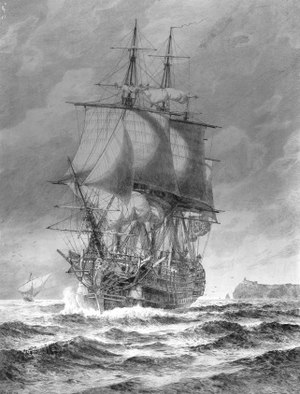Spanish ship Nuestra Señora de la Santísima Trinidad
 Santísima Trinidad
| |
| History | |
|---|---|
| Name | Nuestra Señora de la Santísima Trinidad |
| Namesake | Holy Trinity |
| Ordered | 23 October 1767 |
| Builder | Havana, Cuba |
| Laid down | October 1767 |
| Launched | 20 March 1769 |
| Completed | August 1769 |
| Commissioned | 1 December 1769 |
| Homeport | Cádiz, Spain |
| Fate | Captured at Trafalgar, 21 October 1805; scuttled 22 October. |
| General characteristics | |
| Class and type | 140-gun first-rate |
| Displacement | 4,950 tons |
| Length | 61.3 m (201 ft) |
| Beam | 16.2 m (53 ft) |
| Draught | 8.02 m (26.3 ft) |
| Troops | ≈140 |
| Complement | 1,050 crewmen |
| Armament | |
Nuestra Señora de la Santísima Trinidad, nicknamed La Real, sometimes confused with the merchant galleon
Design and construction
She was built at
There is no complete plan of the ship in existence,[dubious ] but there are of the 112-gun ship from 1765, from which the original dimensions of the ship may be found. Here, the units of length are the Spanish Burgos foot (27.86 cm) and the SI metre (100 cm), respectively: length = 2132⁄3 (59.53); keel = 1825⁄12 (50.82); beam = 573⁄4 (16.09); draught = 2811⁄12 (8.06).[Note 1]
She was reputed to be the largest warship in the world, for which she was nicknamed El Escorial de los mares by the Spanish, until surpassed in sheer size by the new type French 120-gun ships such as Océan (1790) and Orient (1791). In 1795, her forecastle was joined to her quarterdeck to create a fourth deck containing a battery of eight pounder guns, giving her a total of 130 guns. Her armament seems to have been quickly reduced to 130 from 136 guns, but she still carried more guns than any other ship of her time.
The weight of the additional guns, so high above her waterline, made her poor sailing qualities even worse, leading to her nickname El Ponderoso.[2] Some naval officers suggested that she should be restricted to defending the Bay of Cádiz.
Santísima Trinidad remains notable as one of the few four-decker
Service
In July 1779,
On 12 August 1780 she took part in the capture of 55 merchant ships from a convoy of 63, escorted by the ship of the line HMS Ramillies and three frigates.[3] In 1782 she was incorporated into the Mediterranean Squadron, participating in the Great Siege of Gibraltar and she fought in the brief and indecisive Battle of Cape Spartel.[citation needed] In 1795, she was modified by the addition of extra 8-pounder guns on a new deck between her forecastle and quarterdeck.[citation needed]

In 1797, she was the
Eight years later, commanded by Francisco Javier Uriarte and the flagship of
It is possible that her wreck was found by coincidence during testing of a new sidescan sonar of the Spanish Navy, in 2009.[7] An earlier attempt to find her wreck was inconclusive as lack of visual evidence could not confirm the identity of the ships found.[6]
Replicas
A full-size representation[8] of the Santísima Trinidad could be seen in the harbour of Alicante, in Spain. It worked as a restaurant, but has been closed.
A non-profit non-governmental Canadian association, the Friends of Santísima Trinidad,
Notes
- ^ For exact figures, and those in the General characteristics frame, see: José Cayuela Fernandez, Trafalgar, hombres y naves entre dos épocas: Ariel (2004)
Sources and references
- ^ Gervasio de Artinano y de Galdacano, La Arquitectura Naval Espanola (en Madera) (Madrid 1920), p.365
- ^ El Ponderoso, the ponderous is a pun on el poderoso, the powerful.
- ISBN 0-85177-477-6
- ISBN 1-84176-892-8
- ^ Fremont-Barnes and Hook, page 81
- ^ a b "Battle of Trafalgar, Admiral Lord Nelson's Fatal Victory". nationalgeographic.com. National Geographic Magazine. Archived from the original on March 27, 2008. Retrieved 5 June 2017.
- ^ "Have the remains of the Santísima Trinidad been discovered?". www.km.kongsberg.com. Retrieved 5 June 2017.
- ^ "Barco restaurante Santisima Trinidad". 27 May 2016. Retrieved 22 Nov 2019.
- ^ "Friends of the Santísima Trinidad". Archived from the original on 26 July 2011.
Bibliography
- Winfield, Rif; Tredrea, John M; García-Torralba Pérez, Enrique & Blasco Felip, Manuel (2023). Spanish Warships in the Age of Sail 1700—1860: Design, Construction, Careers and Fates. Barnsley, UK: Seaforth Publishing. ISBN 978-1-5267-9078-1.
- John D. Harbron Trafalgar and the Spanish Navy (1988) ISBN 0-87021-695-3
- José Cayuela Fernandez – Trafalgar, hombres y naves entre dos épocas – Ariel (Barcelona) 2004 ISBN 8434467607
External links
- More info with pictures of models
- Website of the Canadian non-profit association, pictures of the construction of the model, history facts and other events Archived 2008-08-26 at the Wayback Machine
